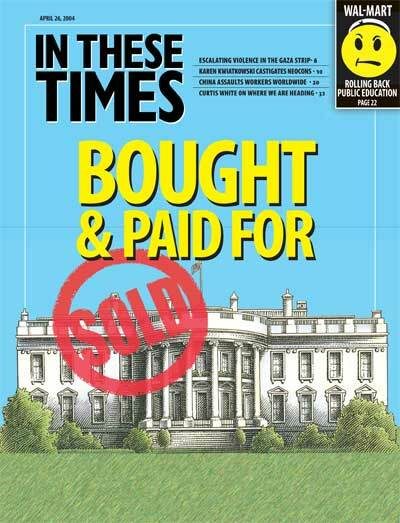
Jim, John, Alice, Sam and Helen may carry the world’s most dangerous genetic markers. They are the Waltons, heirs to the global destructive force called Wal-Mart.
With more than $100 billion in personal assets among them, the five Waltons occupy positions six through 10 in the Forbes billionaires rankings, twice as rich as Microsoft’s Bill Gates, the guy at the top. Collectively, they are antisocial malevolence with a last name. These spawn of Bentonville, Arkansas harbor an abiding hatred for the public sphere: business regulatory controls, nondiscrimination laws, wage and workplace safety standards, the social safety net — all of it — as expressed through the operations of their retail empire, which is both the largest employer in the United States and biggest importer of goods made in China. As the Democratic Socialists of America put it: “Wal-Mart is more than just a participant in the low-wage economy: It is the most important single beneficiary of that economy. It uses its economic and political power to extend the scope of the low-wage economy and threatens to extend its business model into other sectors of the economy, undermining the wages of still more workers.”
Such a vast project of political economy is far too complex for four middle-aged children of wealth and the 84-year-old matriarch, Helen. The family’s immediate personal ambitions are more modest: to destroy public education in the United States. To that end the Waltons, through their Walton Family Foundation and in close collaboration with Milwaukee’s Bradley Foundation, literally invented the national school “choice” network and its wedge issue-weapon, vouchers.
It is the existence of the school vouchers “movement” that allows the Bush administration to savage and massively disrupt the nation’s public schools while positing “alternative” forms of education, both vouchers and charter schools that often operate very much like public-funded private schools. “Choice” has become national policy under Bush’s Department of Education, which has doled out more than $75 million to organizations birthed by the Waltons, Bradley and their allies. (See “Funding a Movement” by People for the American Way, www.pfaw.org.)
Public education’s defenders, already outgunned by the combined resources of the right-wing political funding network plus the full weight of the Republican executive branch, now await the deluge: an infusion of $20 billion into the Walton’s private philanthropy, most of it earmarked for education “reform” — the euphemism for school privatization. At the usual rate of foundation disbursement, this would translate as $1 billion a year — a tidal wave of money, enough to reinvent the voucher “movement” many times over.
The Money Storm
The Waltons’ planned transfer of $20 billion in Wal-Mart stock to the family foundation, most likely precipitated by tax exigencies, was heralded by the corporate media as a boon to prospects for education “reform.” Family voucher impresario John styles himself a savior of inner-city dropouts. “They’re choosing the streets over a school that apparently doesn’t work for them,” Walton told a receptive USA Today reporter. “If choice destroys the public system, then why are we so sanguine about the choices those kids make?”
This minority-aimed wedge has a sharp edge. The obscenely rich Waltons aren’t slumming, but rather are pursuing a super-cynical, fiendishly clever, grand strategy on the way to final victory: destruction of the public sphere. Although the Waltons and their friends would love to franchise (and, ultimately, monopolize) the education “market” — K-12 is worth $350 billion yearly to taxpayers — it is a mistake to view school privatization in vulgar market terms. That’s not how the denizens of right-funded think tanks think.
The public schools by far are the most pervasive public institutions, social spaces, in American society. Therefore, they must be made fully subservient to private capital. To the world-coveters of the Waltons’ class (all several hundred of them, plus their legions of hirelings), public education is more an obstacle than a potential convertible asset.
In the here and now, two forces stand in the way of total corporate hegemony over U.S. political life: Black American voters and organized labor, particularly the teachers unions, whose members are highly active and dependably progressive even in the more reactionary regions of the country. Blacks and labor are the two pillars of the national Democratic Party, without which not even a shell would remain.
Vouchers are the right’s chosen tools to pit African Americans (and more recently, Hispanics) against the teachers unions and labor in general (an ambitious plan, since blacks make up a disproportionate chunk of organized labor). The Waltons and their paid strategists believe they have identified the soft spot in the black body politic: the confluence of African-American reverence for education and the cruel denial of educational justice in the cities. Through relatively small outlays of money — small, that is, for the super-rich — and a great deal of corporate media collaboration, the right has made great strides in just a few years in using the voucher “issue” (it was never an issue for blacks, before) to create the impression that there exists a substantial “alternative,” “conservative” political current in black America. This myth is given credibility through purchase of black spokespersons for the right-funded (and now federally-funded) voucher “movement.” An “alternative” black political leadership is being assembled around school “choice,” totally beholden to the most reactionary elements of corporate America. Should these black compradors gain significant traction, progressive resistance to corporate (and racist) rule in the United States will collapse.
How much traction can a billion dollars a year buy? Nobody in black America has ever seen the kind of money that the Walton Foundation will have at its disposal once the $20 billion stock transfer is completed. The prospect is terrifying.
Progressives are hard pressed, as it is. The two principal advocacy organizations opposed to vouchers are People for the American Way (PFAW) and the NAACP, with annual budgets of about $15 million and $30 million, respectively. The teachers unions — the National Education Association (NEA, 2.7 million members) and the American Federation of Teachers (AFT, 1 million members) spend about $350 million a year combined, for all purposes. Only a tiny fraction of these organizations’ resources can be spared for the anti-voucher fight, while right-wing foundations and the Bush Education Department lavish tens of millions on voucher propaganda, recruitment, cooptation and institution-building.
If the Waltons continue their policy of allocating about 80 percent of their grants to education, and if only half that amount is targeted to “reform” — privatization in one guise or the other — their yearly “choice” war chest would be larger than the combined budgets of the NEA, the AFT, the NAACP and PFAW. That’s overkill.
War Against All
If evil could be branded, its emblem would be the Wal-Mart logo. The retailer has become so large, and behaves so aggressively, it sometimes appears as a force of nature, like weather. Three huge grocery chains with a 70 percent combined national, big-city market share ambushed the United Food and Commercial Workers union this winter, all the while crying that Wal-Mart’s low-wage, few-benefits “model” made them do it. After more than three months on strike and lockout, UFCW President Doug Dority accepted a two-tier, higher premium health coverage settlement. If the Wal-Mart model is a private-sector inevitability, then larger circles of solidarity are the only defense. The UFCW Web site carried Dority’s statement:
We must have national health-care reform. No one company, no one union, no industry or group of workers alone can fix the healthcare system. … Now is the time for action. 2004 is the year to put health care reform on the political agenda and demand that every candidate for office commits to comprehensive, affordable health insurance for every working family.
Labor can’t beat the Wal-Mart model piecemeal, or even if it were united. A larger mobilization is needed.
Wal-Mart shifts the burden of its exploitation to the public, causing federal taxpayers to pay more than $2,000 per employee in social safety net costs to subsidize John, Jim, Sam, Alice and Helen’s profits. In Georgia, Wal-Mart employees’ kids wind up in disproportionate numbers on the state program for uninsured children. Wal-Mart is Georgia’s No. 1 employer, and the state can’t fight that kind of power — not alone.
In Los Angeles, Wal-Mart attempts to usurp the public’s power to decide how communities are developed, asserting a virtual right to barge in where it’s not wanted. Coalition for a Better Inglewood representative the Rev. Altagracia Perez invokes a more comprehensive constituency and a deeper principle:
Despite its track record throughout this country of replacing good jobs with poverty-wage jobs, driving out small businesses and destroying communities, Wal-Mart is asking voters to sign away all their rights to regulate development in their community. If the Wal-Mart initiative goes forward unchallenged, it will send a signal that communities have no role, no voice, no power in the decisions that affect their lives. We cannot let this happen.
The circles of resistance become larger, because the Wal-Mart model attempts to diminish and weaken us all. Wal-Mart wants more than blood — it covets every inch of social space, the places where human civilization lives.
Soon the diabolical Walton family will pump a billion more dollars a year into its offensive against public education, seeking to saturate African-American politics with paid flunkies, drive a wedge between blacks and labor, and cripple the people’s ability to resist.
We must build a bigger circle.





